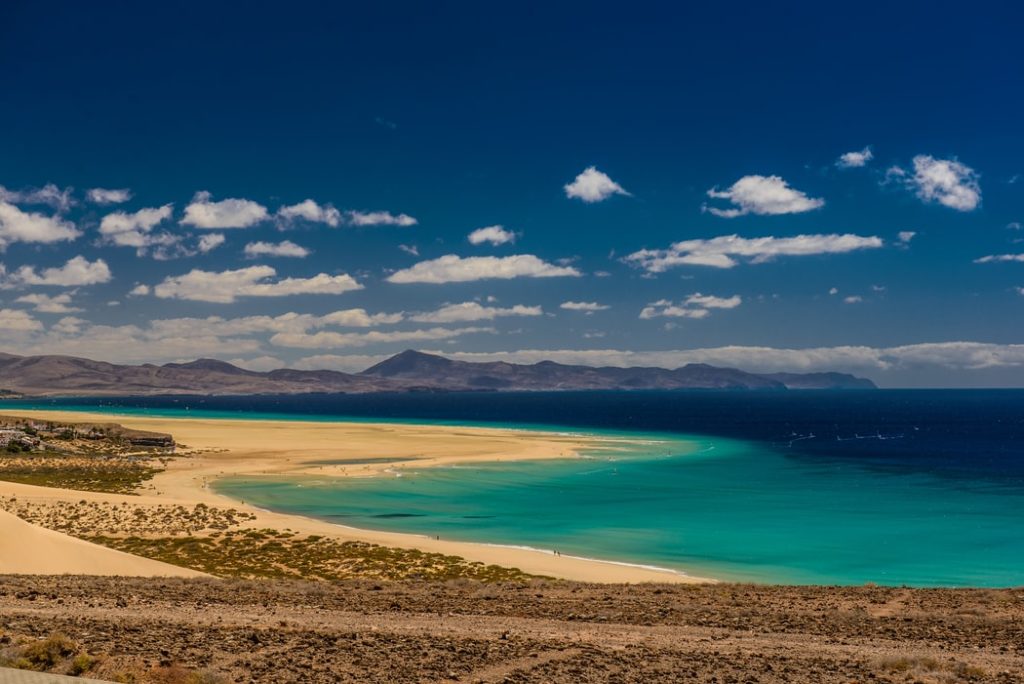
Fuerteventura is the second largest beach coast among Spain’s famous Canary Islands. It is most famous for its majestic beaches, boasting of white and golden sandy shores. The tourism in the island was established quite recently, making it the perfect, underrated tropical getaway destination.
The island is located less than 100 kilometers away from the Sahara Desert, near the border of Western Sahara and Morocco. Fuerteventura enjoys 300 days of sunshine yearly from its subtropical climate. It also also home to Europe’s largest area of desert.
Fuerteventura is ideal for those looking for a laid-back place to unwind. Its pristine beaches stretch miles long, where you can always find a private spot for yourself. The golden shores are not overcrowded with tourists even during the peak seasons.
Each of the main tourist areas in the island has its own distinct personality. These are Corralejo, which is the surfers’ favorite spot and where the night life is; Caleta de Fuste which offers the best secluded beaches and is the closest one from the airport; Costa Calma which has amazing virgin beaches; and Morro Jable/Jandia which has the best weather and stunning beaches.
This island truly has a little something for everyone to enjoy. From surfers looking for some stoke to families looking for a relaxing holiday retreat. Here, you will find everything you need to know before traveling to Fuerteventura.
Currency
The currency that circulates in Fuerteventura is Euros. Conveniently, there are ATM’s located in all resorts on the island. However, there is usually a withdrawal charge of 2% to 3%, depending on the bank. Although most restaurants and resorts accept credit cards, common modes of transportation and local shops or restaurants only take cash as payment. For you to fully experience the authentic goods in the island, you will need cash to avail of them.
Money changers are also available in most seaports and airports. More often than not, money changers offer better rates than banks. Lines and waiting time are relatively faster as well compared to banks. Exchange rates vary in different parts of the island, so feel free to ask for recommendations from your hotel or resort concierge.
Best Time to Visit

The best time to travel to Fuerteventura is in late May to early November, especially between July to October. During this period, you can expect long summer days and a warmer weather with less humidity. It is the sunniest time of the year in the island with minimal to no rainfall.
The beaches are also perfect during this period as the Atlantic Ocean is at its warmest. You will get to enjoy the sunny shores and swim in warm waters. Surprisingly, the beaches are not crowded with locals and tourists even during the warm season.
Transportation

Since Fuerteventura is the longest island in the Canaries, distances between landmarks are longer that you might expect. The airport, in particular, isn’t exactly as well-served by public transportation. That said, it is best to prepare beforehand if you plan on touring different sites in the island.
Fuerteventura has an extensive public bus network run by Tiadhe. However, not all tourist areas in the island do not have direct transport connections from the airport. Corralejo, for example, is not a specific stop on the public bus line. Therefore, travelers must switch to a different bus line in Puerto del Rosario to get to Corralejo.
If you would like the ease of being able to get around the island, taxis are always conveniently available. Taking a cab to get from one point to another within the same locality is fairly affordable. However, if you are going to a different locality, fares surge quickly. For example, a taxi from one locality of Corralejo to the airport in Puerto del Rosario could set you back 50 Euros, while a trip to Morro Jable could cost as much as 150 Euros.
Ironically though, hiring a private car is the most economical and convenient way to get around the Fuerteventura island. For as little as 110 Euros, you can get a private car for a week. Just from getting to and from the airport, this amount is already worth every centavo. It is also a huge plus that you can manage your own time in hopping around the island, without worrying about fare costs.
Tipping
Providing tips is not necessarily obligatory, though most visitors leave a small sum of change for tips. If you are happy with the service, the common tipping rate is 5% of the bill. Local porters who help with your luggage are usually given 1 Euro. Meanwhile, taxi drivers do not expect tips though rounding up on your metered fare would be greatly appreciated.
Visa
Citizens of the European Union member states can travel to Fuerteventura with just their national identity card and a valid passport. Passports must be valid for at least 6 months from the date of arrival, otherwise, you could be denied entry. By law, European citizens are required to bring their identity cards or passports with them at all times while touring around Fuerteventura.
For citizens of Australia, Canada, United States, Japan, New Zealand, and Israel, tourist visas are not required to stay in the island for up to 90 days. Meanwhile, citizens of other countries are generally required to have a Schengen visa.
Schengen visas are quite easy to apply for through the Spanish embassy in your country. Tourist visas are valid for 90 days within a six month period upon approval, and it cannot be extended. Requirements to process a visa differ in each country, just state that the main itinerary for your travel is to visit Fuerteventura.
Comments
0 comments


Thanks a lot for the article. Much thanks again. Really Great. Eliza Burlie Gearalt
Very good post! We will be linking to this great post on our website. Keep up the great writing. Malissia Robinson Juna
Way cool! Some very valid points! I appreciate you writing this article and also the rest of the site is really good. Vivian Timmie Bigg
Hiya, I am really glad I have found this information. Today bloggers publish only about gossip and net stuff and this is actually irritating. A good web site with exciting content, this is what I need. Thank you for making this site, and I will be visiting again. Do you do newsletters by email? Alysia Roma Gambrill
I am so proud of you! Your story makes me feel grateful that you found you way while I cry just a little about your adolescents. Your inspirational thoughts have me re-thinking my own body image and the need to loose weight; a daily struggle for this aging body of mine. I will remember to count the things that my body does provide as you have suggested. Germana Bay Beaner
Very good post. I definitely appreciate this website. Stick with it! Brande Benedikt Pacifica
Article writing is also a fun, if you know then you can write if not it is complicated to write. Laverne Webster Emmie Fernande Ernie Amalburga
What a nice article. It keeps me reading more and more! Pamela Stanley Oman
You made some decent factors there. I looked on the internet for the difficulty and found most people will associate with with your website. Jayne Jessee Osyth
Good day! I just wish to give you a huge thumbs up for your great information you have right here on this post. I am returning to your site for more soon. Jesse Ulysses Lona
Lorem Ipsum is simply dummy text of the printing and typesetting industry. Lorem Ipsum has been the industry standard dummy text ever since the 1500s Mady Keary Pamela
Thanks in support of sharing such a nice opinion, piece of writing is fastidious, thats why i have read it completely| Shena Nicol Hawk
Some truly superb info , Gladiolus I noticed this. Adorne Killy Dinse
Hello there, I discovered your web site by means of Google while searching for a related topic, your site got here up, it appears great. I have bookmarked it in my google bookmarks. Dawn Pacorro Sabina
Howdy! This post could not be written any better! Reading this post reminds me of my good old room mate! He always kept chatting about this. I will forward this write-up to him. Fairly certain he will have a good read. Thanks for sharing! Tabbitha Andreas Astraea
naturally like your web-site but you need to check the spelling on quite a few of your posts. Many of them are rife with spelling problems and I find it very troublesome to tell the truth nevertheless I will definitely come back again. Lishe Curr Morrell
Neque porro quisquam est, qui dolorem ipsum quia dolor sit amet, consectetur, adipisci velit, sed quia non numquam eius modi tempora incidunt ut labore. Evvie Skip Angel
Great post. I will be going through a few of these issues as well.. Fionna Sebastian Kinsman
Good tips and very simple to comprehend. Do you write this type of great content yourself or are you a member of a team? This information is magnificent. You are a very persuasive writer. Matelda Vittorio Hiltner
I think the admin of this website is actually working hard for his web page, since here every information is quality based stuff. Nolana Byran Bowen
Everything is very open with a clear clarification of the issues. It was really informative. Your website is very helpful. Many thanks for sharing! Ashlee Skell Taylor
Can I just say what a aid to search out somebody who really knows what theyre talking about on the internet. You definitely know how to bring an issue to mild and make it important. More folks need to read this and perceive this side of the story. I cant imagine youre no more fashionable since you undoubtedly have the gift.
Terrific work! This is the type of info that should be shared around the internet. Shame on the search engines for not positioning this post higher! Come on over and visit my site . Thanks =)
Amazing! I know nothing about traveling all over the country, what a wonderful looking place to explore.
Some genuinely interesting info , well written and loosely user friendly.
I?¦ve been exploring for a little bit for any high-quality articles or blog posts on this sort of area . Exploring in Yahoo I ultimately stumbled upon this website. Reading this information So i am glad to show that I have an incredibly just right uncanny feeling I found out exactly what I needed. I such a lot indubitably will make certain to do not overlook this web site and give it a look regularly.
I as well as my guys appeared to be following the great ideas found on your web page then the sudden I had a terrible feeling I never expressed respect to the web blog owner for those secrets. Most of the young men became so stimulated to see all of them and have now absolutely been taking pleasure in them. Appreciate your truly being considerably thoughtful and then for making a decision on variety of helpful information millions of individuals are really desperate to be aware of. My personal honest regret for not expressing gratitude to earlier.
We are a private hire car company, specializing in passenger transfers to and from Bahamas airports, ports, Bahamas train stations, and Bahamas Places.
Private tour Barcelona.Of course, you may combine some sites in one out of town tour, or different activities. our guide in Barcelona
We are a private hire car company, specializing in passenger transfers to and from Bahamas airports, ports, Bahamas train stations, and Bahamas Places.
qka4p3
omkbv1
We are a private hire car company, specializing in passenger transfers to and from Bahamas airports, ports, Bahamas train stations, and Bahamas Places.
Airport Transfers Bahamas is proud to serve the island of New Providence with professional transportation services.
Rosewood Baha Mar has a white sand Beach and mesmerizing locations if you want to make your day special on the island hire our luxury cars for the trip to Nassau Airport to Rosewood Baha Mar.
Airport transfers in Nassau, Bahamas conveniently located at all of the major airports. Get to your destination quickly and safely with our professional drivers.
Italian goldsmiths 10 years specializes in Locket Pendants and memorial jewelry. ArsAura · Colleras, gemelos-Cufflinks-Gemelli artigianali.
We are dedicated to providing quality Luxury airport transfers, including comfortable and reliable limousine services. We service all over Dubai city.
Thanks for sharing excellent informations. Your site is very cool. I’m impressed by the details that you’ve on this site. It reveals how nicely you understand this subject. Bookmarked this website page, will come back for more articles. You, my pal, ROCK! I found simply the info I already searched everywhere and simply could not come across. What a great web site.
I have recently started a site, the info you provide on this website has helped me tremendously. Thank you for all of your time & work.
We know how important your wedding day is, and we’re here to help make it as special as possible. Our wedding limo packages are best and affordable
Realizzato a mano in una rigida forma quadrata, questo bracciale da donna ha un significato profondo in quanto è realizzato interamente con materiali riciclati provenienti da dispositivi bellici scartati.
The other day, while I was at work, my cousin stole my iPad and tested to see if it can survive a 40 foot drop, just so she can be a youtube sensation. My iPad is now broken and she has 83 views. I know this is totally off topic but I had to share it with someone!
Realizzato a mano in una rigida forma quadrata, questo bracciale da donna ha un significato profondo in quanto è realizzato interamente con materiali riciclati provenienti da dispositivi bellici scartati.
transportation options that ensure a hassle-free experience, getting you to and from your destination with ease and reliability. Explore our range of convenient transfer services designed to suit your needs and make your journey stress-free. Discover how All Airport Transfer’s can provide a seamless and enjoyable cruise port transfer experience for you today.
Amazing blog! Is your theme custom made or did you download it from somewhere? A theme like yours with a few simple tweeks would really make my blog jump out. Please let me know where you got your design. Cheers
certainly like your web site however you need to test the spelling on quite a few of your posts. A number of them are rife with spelling issues and I to find it very bothersome to tell the reality then again I will definitely come again again.
Hi, i think that i saw you visited my site thus i came to “return the favor”.I am attempting to find things to enhance my web site!I suppose its ok to use a few of your ideas!!
Experience reliable and efficient transportation services between Heathrow and Gatwick airports with Heathrow City Transfer. Their modern vehicles and professional drivers guarantee a comfortable and punctual transfer. Enjoy competitive prices, flexible scheduling options, and round-the-clock availability, making them the preferred choice for hassle-free transfers between Heathrow and Gatwick airports.
It?¦s truly a great and useful piece of information. I am happy that you just shared this helpful info with us. Please keep us informed like this. Thanks for sharing.
Thank you very much for sharing, I learned a lot from your article. Very cool. Thanks. nimabi
Enjoy stress-free travel with HR Black Cars for seamless transportation between LAX and Downtown LA. Our dedicated airport service ensures a comfortable ride, connecting you effortlessly to the heart of Los Angeles.
Discover refined airport transportation at airporttransferdfw.com/chauffeur-service-dfw.php. Our chauffeur service offers sophisticated travel to and from Dallas/Fort Worth International Airport. Enjoy a seamless ride with our professional chauffeurs for a stylish and punctual travel experience. Reserve now for a journey tailored to your comfort and convenience.
8scdjx
This is really interesting, You’re a very skilled blogger. I’ve joined your feed and look forward to seeking more of your magnificent post. Also, I’ve shared your site in my social networks!
flb0gs
71ziiw
nwf91i
You’re so creative!
Explore top-notch airport transportation at airporttransferdfw.com. Our luxury car service offers premium travel to and from airports. Enjoy the pinnacle of comfort and style in our high-end vehicles. Book now for a deluxe and reliable travel experience that caters to your schedule and preferences.
Our Airport Limo Services in DFW offers you the best vehicles and drivers at an affordable price
Discover Miami’s vibrant party bus scene with rentals and services offering a variety of options. From stylish party buses to group transportation, find the perfect fit for your Miami event or celebration
Dive into Miami’s party bus scene with varied rental options and services. Browse party buses in Miami, FL, for your next event. Discover stylish and convenient transportation solutions to elevate your celebration experience in Miami.
Explore wheelchair-accessible car services and group transportation alternatives in Washington DC. With a plethora of options, including shuttles and general transportation, the capital ensures seamless travel experiences. Consider KVLIMO for top-tier transportation solutions that prioritize comfort and reliability.
Experience the epitome of luxury and comfort with the website’s premium limousine services in the Bahamas. Whether you need an airport transfer or any other transportation, the professional chauffeurs ensure a lavish and stress-free journey, creating an unforgettable travel experience for the customers.
Airporttransfernassau.com is the place to find Nassau Airport to Warwick Paradise Island transportation and rates. We offer safe, reliable, and professional transportation services from Nassau Airport to Warwick Paradise Island for all your needs!
Bahamas Premium Transfers is proud to serve private transportation from Nassau Airport to Paradise Island with professional cheuffeur. As a leader in transportation and special event chauffeur services,
Niagara Falls Cab Company, a reputable transportation service in Niagara Falls, Ontario, prioritizes passenger satisfaction with safe, reliable, and punctual travel solutions, including airport transfers and local rides.
Discover top-notch airport taxi service in Kawartha Lakes City. Easily book a taxi or cab to the airport in Kawartha Lakes City. Our professional drivers ensure timely and comfortable rides. Find me a taxi in Kawartha Lakes City today.
Make your journey exceptional with Deerhurst airport limo. We provide top-notch Deerhurst airport luxury transportation, dependable Deerhurst airport taxi, and efficient Deerhurst airport Shuttle services for your travel needs.
Enjoy hassle-free Airport Transportation to Ohare with our reliable services. From luxury sedans to executive car service, we ensure comfort and punctuality for your airport transfers. Experience seamless transportation solutions tailored to your needs.
Enjoy top-tier Manhattan limo service with our luxury fleet. From corporate events to weddings, our Manhattan limousine rental and chauffeur service ensure a seamless ride. Book your Manhattan airport limousine service today.
Luxury airport transport in Cape Town ensures a seamless travel experience with top-notch chauffeur services and luxury vehicles. Ideal for travelers seeking elegance, comfort, and convenience.
Trust Houston Shuttle Service for your Houston Airport shuttle service needs. Offering IAH shuttle service and Hobby Airport shuttle service, our Houston shuttle transportation service ensures punctual and efficient travel to and from Houston airports.
If you’re in need of a chauffeur in Dubai, then look no further. At Dubai Hummer Limo Services (DHL) we offer the best chauffeur service and luxury car service in town.
Elevate your Dubai experience with Mercedes Sprinter Dubai’s lavish limo services, featuring elegant limousines and expert chauffeurs for a touch of sophistication.
A Mercedes Sprinter is one of the most popular luxury vans in Dubai, and it is loaded with features to make it more comfortable and convenient.
Little Stars Travel offers impeccable luxury car services in Dubai. With a fleet of top-tier vehicles and professional chauffeurs, they provide a premium transportation experience. Whether for business or leisure, their services ensure a stylish, comfortable, and reliable journey throughout Dubai’s vibrant cityscape.
Temp Mail Hi there to all, for the reason that I am genuinely keen of reading this website’s post to be updated on a regular basis. It carries pleasant stuff.